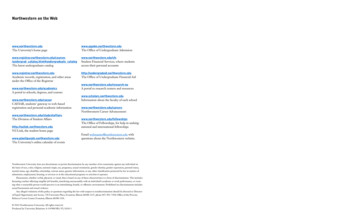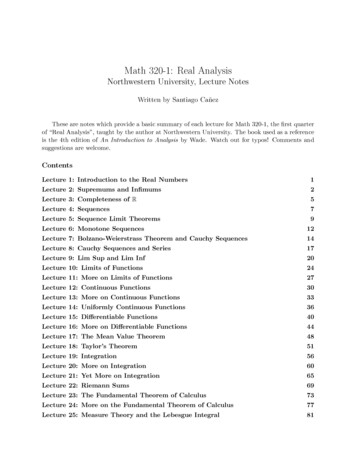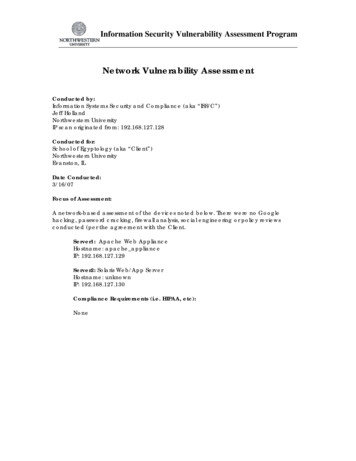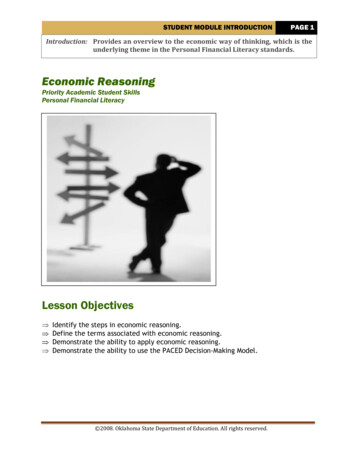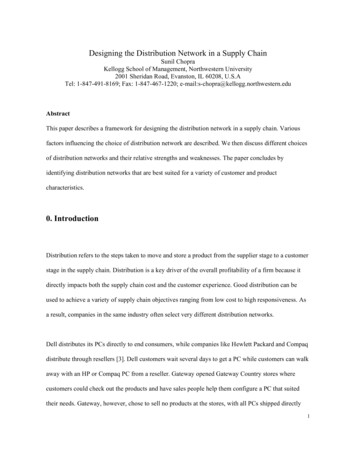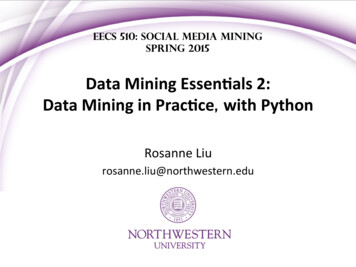
Transcription
Introduction toEconomic AnalysisVersion 2.1R. Preston McAfee;Tracy Lewis;Donald J. DaleIntroduction to Economic Analysis1-1
Introduction to Economic Analysis1-2
About the AuthorsABOUT R. PRESTON MCAFEER. Preston McAfee received his undergraduate degree in economics from the University of Florida, andmaster of science in mathematics, and a Ph.D in economics from Purdue University. McAfee is the J.Stanley Johnson Professor of Business, Economics & Management at Caltech. He is on leave fromCaltech and currently is Chief Economist at Microsoft.The author of many academic papers on auctions, McAfee was one of the designers of the FederalCommunication Commission’s first auction of radio spectrum rights for cellular phones. Over 100 billionworth of airwaves and other items have been sold using this auction design. He has run auctions in Mexicoand advised several governments on auction use.McAfee served as an economic expert in a variety of antitrust cases, including Exxon-Mobil, BPArco, Lockheed Martin-Northrop Grumman, and Peoplesoft-Oracle. He also testified in the U.S. versus Rambus, and has testified beforethree United States Senate committees on antitrust enforcement and gasoline pricing.ABOUT TRACY R. LEWISTracy R. Lewis is the Martin L Black Professor of Business Administration at the Fuqua School ofBusiness, Duke University, and Director of the Duke University Innovation Center.Other positions held by Dr. Lewis include: James Walter Eminent Scholar in Economics, Universityof Florida, and Associate Director of Energy Studies, Public Utilities Research Center, Director, Programon Workable Energy Regulation (POWER), Professor of Economics, University of California, Davis,Professor of Economics, University of British Columbia, Assistant Director, Program in Natural ResourceEconomics, Visiting Associate Professor of Economics, California Institute of Technology, AssociateProfessor of Economics, University of British Columbia, Brookings Fellow, Washington, DC, VisitingAssistant Professor, University of British Columbia, Assistant Professor, University of Arizona.In addition to the roles above, Dr. Lewis has served as Economic Advisor for the National ResearchCouncil, Academy of Sciences. He has been a consultant to numerous organizations including the FloridaAttorney General’s Office, the World Bank Project on Abatement of Greenhouse Gases, Florida Powerand Light Company, FTC, Department of Energy, the Rand Corporation, and many others.Dr. Lewis has published two books, numerous articles, and has served as editor on a wide range of journals including: the Journalof Law Economics and Organization, The B. E. Journals in Industrial Organization, and Review of Network Economics–to name a few.He has been awarded over 15 grants, fellowships and awards.Tracy earned his BA and PhD at the University of California, San Diego.ABOUT DONALD J. DALEDonald J. Dale is Clinical Associate Professor of Economics at the Kellogg School of Management atNorthwestern University. The winner of several teaching awards, he has taught microeconomics for24 years. He is interested in experimental economic methods for both research and pedagogy. Dr.Dale has conference presentations and publications in the fields of game theory, experimentaleconomics, and experimental psychology. Dr. Dale received his undergraduate degree from theUniversity of Delaware, and his MS and Ph.D. from Princeton University.Introduction to Economic Analysis1-3
Contents123456WHAT IS ECONOMICS? . 1-81.1NORMATIVE AND POSITIVE THEORIES . 1-81.2OPPORTUNITY COST . 1-91.3ECONOMIC REASONING AND ANALYSIS . 1-11SUPPLY AND DEMAND. 2-142.1DEMAND AND CONSUMER SURPLUS. 2-142.2SUPPLY AND PROFIT . 2-192.3MARKET DEMAND AND SUPPLY. 2-222.4EQUILIBRIUM . 2-232.5CHANGES IN DEMAND AND SUPPLY . 2-24QUANTIFICATION . 3-283.1ELASTICITY . 3-283.2SUPPLY AND DEMAND CHANGES . 3-30THE US ECONOMY . 4-334.1BASIC DEMOGRAPHICS . 4-334.2EDUCATION . 4-394.3HOUSEHOLDS AND CONSUMPTION. 4-414.4PRODUCTION . 4-474.5GOVERNMENT . 4-554.6TRADE . 4-634.7FLUCTUATIONS. 4-66GOVERNMENT INTERVENTIONS . 5-695.1EFFECTS OF TAXES . 5-695.2INCIDENCE OF TAXES . 5-725.3EXCESS BURDEN OF TAXATION . 5-735.4PRICE FLOORS AND CEILINGS . 5-745.5THE POLITICS OF PRICE CONTROLS . 5-795.6PRICE SUPPORTS . 5-825.7QUANTITY RESTRICTIONS AND QUOTAS . 5-83TRADE. 6-856.1PRODUCTION POSSIBILITIES FRONTIER . 6-856.2COMPARATIVE AND ABSOLUTE ADVANTAGE . 6-886.3FACTORS OF PRODUCTION . 6-906.4INTERNATIONAL TRADE . 6-91Introduction to Economic Analysis1-4
789EXTERNALITIES . 7-937.1EXTERNAL EFFECTS. 7-937.2PIGOUVIAN TAXES . 7-977.3QUOTAS . 7-987.4TRADABLE PERMITS AND AUCTIONS . 7-997.5COASIAN BARGAINING . 7-1007.6FISHING AND EXTINCTION. 7-101PUBLIC GOODS . 8-1058.1FREE-RIDERS . 8-1058.2PROVISION WITH TAXATION . 8-1078.3LOCAL PUBLIC GOODS . 8-108PRODUCER THEORY: COSTS . 9-1109.1TYPES OF FIRMS . 9-1109.2PRODUCTION FUNCTIONS. 9-1129.3PROFIT MAXIMIZATION. 9-1159.4THE SHADOW VALUE. 9-1199.5INPUT DEMAND . 9-1209.6MYRIAD COSTS . 9-12210 PRODUCER THEORY: DYNAMICS . 10-12510.1REACTIONS OF COMPETITIVE FIRMS.10-12510.2ECONOMIES OF SCALE AND SCOPE .10-12710.3DYNAMICS WITH CONSTANT COSTS .10-13010.4GENERAL LONG-RUN DYNAMICS .10-13511 INVESTMENT . 11-14011.1PRESENT VALUE .11-14011.2INVESTMENT .11-14311.3INVESTMENT UNDER UNCERTAINTY .11-14411.4RESOURCE EXTRACTION .11-14811.5A TIME TO HARVEST .11-14911.6COLLECTIBLES.11-15111.7SUMMER WHEAT .11-15512 CONSUMER THEORY . 12-15712.1UTILITY MAXIMIZATION .12-15712.2BUDGET OR FEASIBLE SET .12-15812.3INDIFFERENCE CURVES .12-16112.4EXAMPLES .12-16412.5SUBSTITUTION EFFECTS .12-16612.6INCOME EFFECTS .12-169Introduction to Economic Analysis1-5
12.7MATHEMATICAL CLEANUP .12-17213 APPLIED CONSUMER THEORY . 13-17413.1LABOR SUPPLY .13-17413.2URBAN REAL ESTATE PRICES .13-17813.3DYNAMIC CHOICE .13-18113.4RISK AVERSION.13-18513.5SEARCH.13-18914 GENERAL EQUILIBRIUM . 14-19214.1EDGEWORTH BOXES .14-19214.2EQUILIBRIUM WITH PRICE SYSTEM .14-19514.3GENERAL EQUILIBRIUM .14-19915 MONOPOLY . 15-20515.1SOURCES OF MONOPOLY.15-20515.2BASIC ANALYSIS .15-20615.3EFFECT OF TAXES .15-20915.4PRICE DISCRIMINATION .15-21015.5WELFARE EFFECTS .15-21315.6NATURAL MONOPOLY .15-21415.7PEAK LOAD PRICING .15-21516 GAMES & STRATEGIC BEHAVIOR . 16-21816.1MATRIX GAMES .16-21816.2NASH EQUILIBRIUM.16-22116.3MIXED STRATEGIES .16-22316.4EXAMPLES .16-22616.5SUBGAME PERFECTION .16-22916.6SUPERGAMES .16-23217 IMPERFECT COMPETITION . 17-23517.1COURNOT OLIGOPOLY .17-23517.2COURNOT INDUSTRY PERFORMANCE .17-23717.3HOTELLING DIFFERENTIATION.17-23917.4THE CIRCLE MODEL .17-24118 INFORMATION. 18-24418.1MARKET FOR LEMONS .18-24418.2MYERSON-SATTERTHWAITE THEOREM .18-24518.3SIGNALING .18-24718.4SEARCH AND PRICE DISPERSION .18-24819 AGENCY THEORY . 19-25219.1PRINCIPALS AND AGENTS.19-252Introduction to Economic Analysis1-6
19.2COST OF PROVIDING INCENTIVES .19-25419.3MULTI-TASKING.19-25619.4MULTI-TASKING WITHOUT HOMOGENEITY .19-25920 AUCTIONS. 20-26220.1ENGLISH AUCTION .20-26220.2SEALED-BID AUCTION .20-26320.3DUTCH AUCTION .20-26520.4VICKREY AUCTION .20-26620.5THE WINNER’S CURSE AND LINKAGE .20-26720.6AUCTION DESIGN.20-27021 ANTITRUST . 21-27221.1SHERMAN ACT .21-27221.2CLAYTON ACT .21-27321.3PRICE-FIXING .21-27521.4MERGERS .21-27622 SOLUTIONS TO EXERCISES . 22-280Introduction to Economic Analysis1-7
1What is Economics?Economics studies the allocation of scarce resources among people – examining what goods and services wind up in the hands ofwhich people. Why scarce resources? Absent scarcity, there is no significant allocation issue. All practical, and many impractical,means of allocating scarce resources are studied by economists. Markets are an important means of allocating resources, soeconomists study markets. Markets include stock markets like the New York Stock Exchange, commodities markets like the ChicagoMercantile, but also farmer’s markets, auction markets like Christie’s or Sotheby’s (made famous in movies by people scratching theirnoses and inadvertently purchasing a Ming vase) or eBay, or more ephemeral markets, such as the market for music CDs in yourneighborhood. In addition, goods and services (which are scarce resources) are allocated by governments, using taxation as a meansof acquiring the items. Governments may be controlled by a political process, and the study of allocation by the politics, which isknown as political economy, is a significant branch of economics. Goods are allocated by certain means, like theft, deemed illegal bythe government, and such allocation methods nevertheless fall within the domain of economic analysis; the market for marijuanaremains vibrant despite interdiction by the governments of most nations. Other allocation methods include gifts and charity, lotteriesand gambling, and cooperative societies and clubs, all of which are studied by economists.Some markets involve a physical marketplace. Traders on the New York Stock Exchange get together in a trading pit. Traders oneBay come together in an electronic marketplace. Other markets, which are more familiar to most of us, involve physical stores thatmay or may not be next door to each other, and customers who search among the stores, purchasing when the customer finds anappropriate item at an acceptable price. When we buy bananas, we don’t typically go to a banana market and purchase from one of adozen or more banana sellers, but instead go to a grocery store. Nevertheless, in buying bananas, the grocery stores compete in amarket for our banana patronage, attempting to attract customers to their stores and inducing them to purchase bananas.Price – exchange of goods and services for money – is an important allocation means, but price is hardly the only factor even inmarket exchanges. Other terms, such as convenience, credit terms, reliability, and trustworthiness are also valuable to the participantsin a transaction. In some markets such as 36 inch Sony WEGA televisions, one ounce bags of Cheetos, or Ford Autolite spark plugs,the products offered by distinct sellers are identical, and for such products, price is usually the primary factor considered by buyers,although delivery and other aspects of the transaction may still matter. For other products, like restaurant meals, camcorders bydifferent manufacturers, or air travel on distinct airlines, the products differ to some degree, and thus the qualities of the product arefactors in the decision to purchase. Nevertheless, different products may be considered to be in a single market if the products arereasonable substitutes, and we can consider a “quality-adjusted” price for these different goods.Economic analysis is used in many situations. When British Petroleum sets the price for its Alaskan crude oil, it uses an estimateddemand model, both for gasoline consumers and also for the refineries to which BP sells. The demand for oil by refineries isgoverned by a complex economic model used by the refineries and BP estimates the demand by refineries by estimating the economicmodel used by refineries. Economic analysis was used by experts in the antitrust suit brought by the U.S. Department of Justice bothto understand Microsoft’s incentive to foreclose (eliminate from the market) rival Netscape and consumer behavior in the face ofalleged foreclosure. Stock market analysts use economic models to forecast the profits of companies in order to predict the price oftheir stocks. When the government forecasts the budget deficit or considers a change in environmental regulations, it uses a variety ofeconomic models. This book presents the building blocks of the models in common use by an army of economists thousands of timesper day.1.1Normative and Positive TheoriesLearning Objectives How is economics used? What is an economic theory? What is a market?Economic analysis is used for two main purposes. The first is a scientific understanding of how allocations of goods and services –scarce resources – are actually determined. This is a positive analysis, analogous to the study of electromagnetism or molecularbiology, and involves only the attempt to understand the world around us. The development of this positive theory, however,suggests other uses for economics. Economic analysis suggests how distinct changes in laws, rules and other governmentinterventions in markets will affect people, and in some cases, one can draw a conclusion that a rule change is, on balance, sociallybeneficial. Such analyses combine positive analysis – predicting the effects of changes in rules – with value judgments, and areknown as normative analyses. For example, a gasoline tax used to build highways harms gasoline buyers (who pay higher prices), buthelps drivers (who face fewer potholes and less congestion). Since drivers and gasoline buyers are generally the same people, anormative analysis may suggest that everyone will benefit. This type of outcome, where everyone is made better off by a change, isrelatively uncontroversial.Introduction to Economic Analysis1-8
In contrast, cost-benefit analysis weighs the gains and losses to different individuals and suggests carrying
Donald J. Dale is Clinical Associate Professor of Economics at the Kellogg School of Management at Northwestern University. The winner of several teaching awards, he has taught microeconomics for 24 years. He is interested in experime
